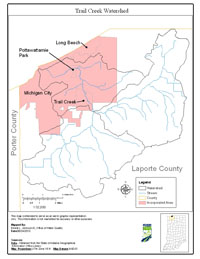Location
The Trail Creek Watershed is located in Northwest Indiana, draining approximately 59 square miles in LaPorte County. Major streams included in the Total Maximum Daily Load (TMDL) report are Trail Creek, East and West Branch Trail Creek.
History
A comprehensive survey of the Trail Creek Watershed was complied through Indiana Department of Environmental Management (IDEM), U.S. EPA’s Storage and Retrieval System (STORET), USGS databases, Michigan City Wastewater Treatment Plant (WWTP), LaPorte County Health and the Michigan City Sanitary District in 2004 and 2007. The primary cause of impairment is Escherichia coli bacteria (E. coli). Pollution sources in the watershed include nonpoint sources from agriculture and pastures, land application of manure and urban and rural run-off, as well as point sources from straight pipe discharges, home sewage treatment system disposal and combined sewer overflow outlets.
Pollutants Addressed
TMDLs for the Trail Creek Watershed are established for E. coli and will address four impairments. Some of the recommended solutions to address the impairments include storm water controls, point source controls, manure management and habitat improvements.
Timeline
A kickoff TMDL meeting was held on July 25, 2002 at the Northwest Regional Planning Commission, 6100 Southport Rd., Portage, Indiana, starting at 9:00 a.m.
A draft TMDL meeting was held on September 15, 2003 at the Northwest Indiana Regional Planning Commission, 6100 Southport Rd., Portage, Indiana starting at 6:00 p.m.
The 30-day public comment period for the draft Trail Creek Watershed TMDL began on September 15, 2003 and ended on October 15, 2003.
U.S. EPA under Section 303(d) of the Clean Water Act approved the Trail Creek Watershed TMDL report on March 1, 2004 for four impairments. TMDL reports identify and evaluate water quality problems in impaired water bodies and propose solutions to bring those waters into attainment with water quality standards.

